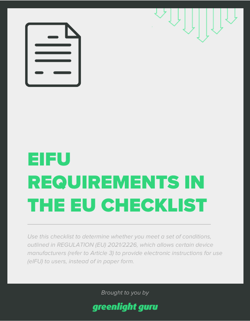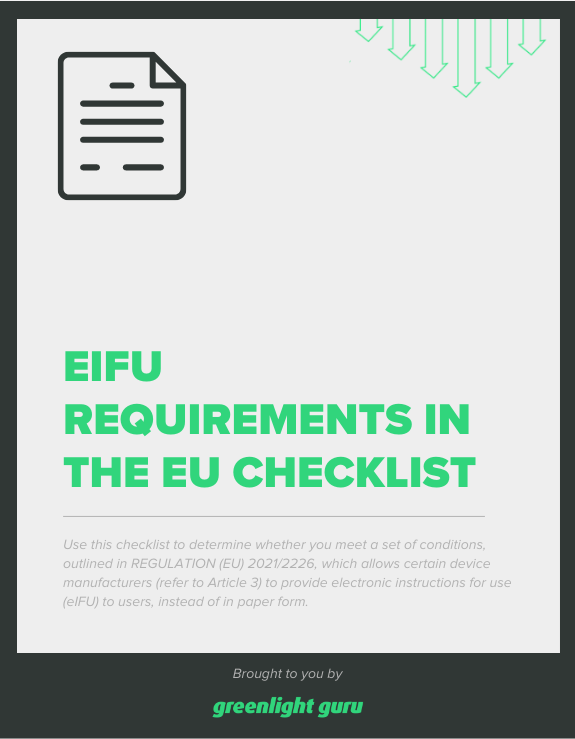eIFU Requirements: Everything You Need to Know About Electronic Instructions for Use

It doesn’t matter how well-engineered or high-quality your medical device is; you still need to make sure people know how to use it.
Instructions for use (IFU) are a critical part of the information that manufacturers are expected to supply to end users along with the device itself. And while in the past this may have taken the form of a sheet or two of paper, crammed with as much information as possible—in as many languages as possible—things are beginning to change.
We live in a digital world, and in many cases, providing IFU in paper form is no longer the best option. Instead, medical device companies are increasingly relying on electronic instructions for use (eIFU).
So, today I want to take some time to discuss eIFU, how they’re regulated, and why you may (or may not) want to use them.
FREE RESOURCE: Click here to download your free PDF copy of our eIFU Requirements in the EU checklist.
What is an IFU and what is an eIFU (electronic instructions for use)?
Instructions for use are generally defined as the information a medical device manufacturer provides end users about the intended use of the device, its proper use, and any precautions they should take while using the device.
The “e” in eIFU simply refers to the method of delivery for those instructions. Rather than using paper, the instructions are delivered electronically. Depending on the device, this can happen in a couple of different ways.
If the medical device has a large display screen, the eIFU may be delivered via the device’s display. However, for devices lacking a display, such as implantable devices, the manufacturer may make the eIFU available on their website.
What regulations and guidance apply to eIFU?
There are a few regulations and guidance documents you need to be familiar with if you’re planning on selling your medical device or in vitro diagnostic (IVD) in the US or the EU.
In the EU, the requirements for information to be provided with the device, which covers eIFU, can be found in Annex 1, Chapter III of EU MDR:
Instructions for use may be provided to the user in non-paper format (e.g. electronic) to the extent, and only under the conditions, set out in Regulation (EU) No 207/2012 or in any subsequent implementing rules adopted pursuant to this Regulation.
Clause 23.1 (f) of Annex 1, Chapter III refers readers to Regulation 207/2012 for more information on eIFU. However, Regulation 207/2012 has recently been repealed and replaced with Regulation 2021/2226. This new regulation aligns with EU MDR and lays down the rules for when and how manufacturers may provide eIFU in a non-paper format.
In the US, FDA addresses IFU in 21 CFR Part 801.5. Unfortunately, section 801.5 says nothing about electronic delivery, and there is little formal guidance on their use, compared to the EU regulations.
Still, FDA does allow manufacturers to deliver eIFU rather than in paper form. Section 352(f) of the Federal Food, Drug and Cosmetic Act states:
Required labeling for prescription devices intended for use in health care facilities may be made available solely by electronic means provided that the labeling complies with all applicable requirements of law and, that the manufacturer affords health care facilities the opportunity to request the labeling in paper form, and after such request, promptly provides the health care facility the requested information without additional cost.
Finally, it’s also a good idea to familiarize yourself with ISO 20417. This guidance document for medical devices covers information to be supplied by the manufacturer and takes into account both MDR and IVDR as well as guidance from the International Medical Device Regulatory Forum (IMDRF).
What are the benefits and drawbacks of eIFU?
There are a number of benefits to using eIFU instead of paper instructions—for both medical device manufacturers and end users:
-
For one thing, eIFU cannot be destroyed or misplaced in the same way as paper IFU. As long as the instructions are available online, they can be accessed by end users.
-
Manufacturers also benefit, as they are able to cut the costs associated with printing physical IFU, packaging them with the device, and the burden of heightened sterilization dosages due to the added density of the paper.
-
Electronic IFU can also be updated far more quickly than paper IFU. If safety information changes due to postmarket surveillance activities, the eIFU can be changed immediately to reflect it.
-
Manufacturers also have the opportunity to be more creative and forward-thinking in how they communicate instructions in eIFU. Animations, videos, voiceovers, and links to helpful resources are all possibilities once you move from paper to a digital format.
-
Finally, when you use eIFU, the number of languages available is not limited by the size of the piece of paper they are printed on.
As great as that all sounds, there are some potential drawbacks to using eIFU. You may need to consider a number of potential issues with electronic instructions:
-
One of the more pressing concerns for eIFU is the fact that without an internet connection, they will not be available to end users unless they have previously downloaded them. Even in areas with widespread coverage, internet outages are not uncommon, and this issue is worth taking into account for some devices.
-
There are also plenty of design challenges that manufacturers must tackle with eIFU. For example, if the instructions appear on the device’s main screen, there may be issues with switching back and forth from the instructions to the operational display.
-
Additionally, manufacturers must ensure that nothing is lost when information moves from a single page to a succession of screens or a scrolling experience. For instance, warning labels that are always within sight on a piece of paper may only be occasionally present on a screen.
These are not insurmountable challenges, but they do provide some context for laws like the FD&C Act, which require manufacturers to offer paper alternatives when requested.
FREE RESOURCE: Click here to download your free PDF copy of our eIFU Requirements in the EU checklist.
Use Greenlight Guru to comply with electronic instructions for use and other labeling requirements
With new regulations, standards, and guidance coming out all the time, it can be difficult to stay up-to-date with the latest requirements in medical device manufacturing.
We built Greenlight Guru’s QMS Software because we wanted to relieve the burden of compliance—and let you focus on True Quality. Our comprehensive, end-to-end software solution is based on the latest FDA and ISO standards, as well as best practices of medical device manufacturers who lead the industry in production of high-quality devices.
Get your free demo of Greenlight Guru today and see just how powerful a purpose-built, industry-specific solution can be for your medical device company.
Etienne Nichols is the Head of Industry Insights & Education at Greenlight Guru. As a Mechanical Engineer and Medical Device Guru, he specializes in simplifying complex ideas, teaching system integration, and connecting industry leaders. While hosting the Global Medical Device Podcast, Etienne has led over 200...
Read More Posts
QMSR Mythbusters Episode
The “just enough” QMS: what does your pre-market team really need?
Did Christmas come early to the EU? Proposal to simplify EUMDR
Get your free PDF
Checklist: eIFU Requirements in the EU











